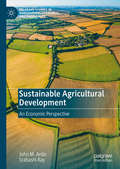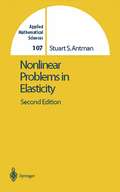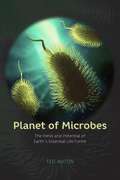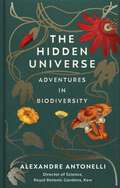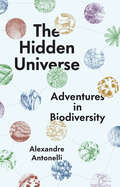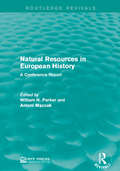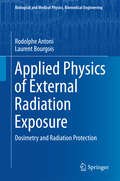- Table View
- List View
Fast Transverse Beam Instability Caused by Electron Cloud Trapped in Combined Function Magnets (Springer Theses)
by Sergey A. AntipovThis thesis presents profound insights into the origins and dynamics of beam instabilities using both experimental observations and numerical simulations. When the Recycler Ring, a high-intensity proton beam accelerator at Fermi National Accelerator Laboratory, was commissioned, it became evident that the Recycler beam experiences a very fast instability of unknown nature. This instability was so fast that the existing dampers were ineffective at suppressing it. The nature of this phenomenon, alongside several other poorly understood features of the beam, became one of the biggest puzzles in the accelerator community. The author investigated a hypothesis that the instability arises from an interaction with a dense cloud of electrons accompanying the proton beam. He studied the phenomena experimentally by comparing the dynamics of stable and unstable beams, by numerically simulating the build-up of the electron cloud and its interaction with the beam, and by constructing an analytical model of an electron cloud-driven instability with the electrons trapped in combined-function dipole magnets. He has devised a method to stabilize the beam by a clearing bunch, which conclusively revealed that the instability is caused by the electron cloud, trapped in a strong magnetic field. Finally, he conducted measurements of the microwave propagation through a single dipole magnet. These measurements have confirmed the presence of the electron cloud in combined-function magnets.
Pesticide Policy, Production Risk, and Producer Welfare: An Econometric Approach to Applied Welfare Economics (Routledge Revivals)
by John M. AntleThe use of pesticides to control agricultural pests both benefits farm production and imposes health and environmental costs on producers and society. This title, first published in 1988, includes an application of the author’s methodology to tomato production, in which Antle illuminates the roles that alternative methods of pest management play in producer welfare. He also develops a more general empirical framework for studying producer welfare under uncertainty – a framework in which production risk, sequential decision making, and attitudes toward risk are integrated. This title will be of interest to students of environmental studies.
Pesticide Policy, Production Risk, and Producer Welfare: An Econometric Approach to Applied Welfare Economics (Routledge Revivals)
by John M. AntleThe use of pesticides to control agricultural pests both benefits farm production and imposes health and environmental costs on producers and society. This title, first published in 1988, includes an application of the author’s methodology to tomato production, in which Antle illuminates the roles that alternative methods of pest management play in producer welfare. He also develops a more general empirical framework for studying producer welfare under uncertainty – a framework in which production risk, sequential decision making, and attitudes toward risk are integrated. This title will be of interest to students of environmental studies.
Sustainable Agricultural Development: An Economic Perspective (Palgrave Studies in Agricultural Economics and Food Policy)
by John M. Antle Srabashi RayThis book provides a non-technical, accessible primer on sustainable agricultural development and its relationship to sustainable development based on three analytical pillars. The first is to understand agriculture as complex physical-biological-human systems. Second is the economic perspective of understanding tradeoffs and synergies among the economic, environmental and social dimensions of these systems at farm, regional and global scales. Third is the understanding of these agricultural systems as the supply side of one sector of a growing economy, interacting through markets and policies with other sectors at local, national and global scales. The first part of the book introduces the concept of sustainability and develops an analytical framework based on tradeoffs quantified using impact indicators in the economic, environmental and social domains, linking this framework to the role of agriculture in economic growth and development. Next the authors introduce the reader to the sustainability challenges of major agroecosystems in the developing and industrialized worlds. The concluding chapter discusses the design and implementation of sustainable development pathways, through the expression of consumers’ desire for sustainably produced foods on the demand side of the food system, and through policies on the supply side such as new more sustainable technologies, environmental regulation and payments for ecosystem services.
Nonlinear Problems of Elasticity (Applied Mathematical Sciences #107)
by Stuart AntmanThe scientists of the seventeenth and eighteenth centuries, led by Jas. Bernoulli and Euler, created a coherent theory of the mechanics of strings and rods undergoing planar deformations. They introduced the basic con cepts of strain, both extensional and flexural, of contact force with its com ponents of tension and shear force, and of contact couple. They extended Newton's Law of Motion for a mass point to a law valid for any deformable body. Euler formulated its independent and much subtler complement, the Angular Momentum Principle. (Euler also gave effective variational characterizations of the governing equations. ) These scientists breathed life into the theory by proposing, formulating, and solving the problems of the suspension bridge, the catenary, the velaria, the elastica, and the small transverse vibrations of an elastic string. (The level of difficulty of some of these problems is such that even today their descriptions are sel dom vouchsafed to undergraduates. The realization that such profound and beautiful results could be deduced by mathematical reasoning from fundamental physical principles furnished a significant contribution to the intellectual climate of the Age of Reason. ) At first, those who solved these problems did not distinguish between linear and nonlinear equations, and so were not intimidated by the latter. By the middle of the nineteenth century, Cauchy had constructed the basic framework of three-dimensional continuum mechanics on the founda tions built by his eighteenth-century predecessors.
Nonlinear Problems of Elasticity (Applied Mathematical Sciences #107)
by Stuart AntmanEnlarged, updated, and extensively revised, this second edition illuminates specific problems of nonlinear elasticity, emphasizing the role of nonlinear material response. Opening chapters discuss strings, rods, and shells, and applications of bifurcation theory and the calculus of variations to problems for these bodies. Subsequent chapters cover tensors, three-dimensional continuum mechanics, three-dimensional elasticity , general theories of rods and shells, and dynamical problems. Each chapter includes interesting, challenging, and tractable exercises.
Metastability and Incompletely Posed Problems (The IMA Volumes in Mathematics and its Applications #3)
by Stuart S. Antman J. L. Ericksen David Kinderlehrer Ingo MüllerThis IMA Volume in Mathematics and its Applications Metastability and Incompletely Posed Problems represents the proceedings of a workshop which was an integral part of the 19R4-R5 IMA program on CONTINUUM PHYSICS AND PARTIAL DIFFERENTIAL EOIIATIONS. We are grateful to the Scientific Committee: ,I.L. Eri cksen D. Kinderlehrer H. Rrezis C. Dafermos for their dedication and hard work in developing an imaginative, stimulating, and productive year-long program. George R. Sell Hans Weinberger Preface Most equilibrium events in nature do not realize configurations of minimum energy. They are only metastable. Available knowledge of constitutive relations and environmental interactions may be limiterl. As a result, many configurations may he compatible with the rlata. Such questions are incompletely poserl. The papers in this volume address a wide variety of these issues as they are perceived by the material scientist and the mathematician. They represent a portion of the significant activity which has been underway in recent years, from the experimental arena and physical theory to the analysis of differential equations and computation.
Quantization, Coherent States, and Complex Structures
by Jean-Pierre Antoine S. T. Ali W. Lisiecki I. M. Mladenov Anatol OdzijewiczThe XIIIth Bialowieza Summer Workshop was held from July 9 to 15, 1994. While still within the general framework of Differential Geometric Methods in Physics, the XnIth Workshop was expanded in scope to include quantum groups, q-deformations and non-commutative geometry. It is expected that lectures on these topics will now become an integral part of future workshops. In the more traditional areas, lectures were devoted to topics in quantization, field theory, group representations, coherent states, complex and Poisson structures, the Berry phase, graded contractions and some infinite-dimensional systems. Those of us who have taken part in the evolution of the workshops over the years, feel a good measure of satisfaction with the excellent quality of the papers presented, in particular the mathematical rigour and novelty. Each year a significant number of new results are presented and future directions of research are discussed. Their freshness and immediacy inevitably leads to intense discussions and an exchange of ideas in an informal and physically charming environment. The present workshop also had a higher attendance than its predecessors, with ap proximately 65 registered participants. As usual, there was a large number of graduate students and young researchers among them.
Coherent States and Their Applications: A Contemporary Panorama (Springer Proceedings in Physics #205)
by Jean-Pierre Antoine Fabio Bagarello Jean-Pierre GazeauCoherent states (CS) were originally introduced in 1926 by Schrödinger and rediscovered in the early 1960s in the context of laser physics. Since then, they have evolved into an extremely rich domain that pervades virtually every corner of physics, and have also given rise to a range of research topics in mathematics.The purpose of the 2016 CIRM conference was to bring together leading experts in the field with scientists interested in related topics, to jointly investigate their applications in physics, their various mathematical properties, and their generalizations in many directions. Instead of traditional proceedings, this book presents sixteen longer review-type contributions, which are the outcome of a collaborative effort by many conference participants, subsequently reviewed by independent experts.The book aptly illustrates the diversity of CS aspects, from purely mathematical topics to physical applications, including quantum gravity.
Planet of Microbes: The Perils and Potential of Earth's Essential Life Forms
by Ted AntonWe live in a time of unprecedented scientific knowledge about the origins of life on Earth. But if we want to grasp the big picture, we have to start small—very small. That’s because the real heroes of the story of life on Earth are microbes, the tiny living organisms we cannot see with the naked eye. Microbes were Earth’s first lifeforms, early anaerobic inhabitants that created the air we breathe. Today they live, invisible and seemingly invincible, in every corner of the planet, from Yellowstone’s scalding hot springs to Antarctic mountaintops to inside our very bodies—more than a hundred trillion of them. Don’t be alarmed though: many microbes are allies in achieving our—to say nothing of our planet’s—health. In Planet of Microbes, Ted Anton takes readers through the most recent discoveries about microbes, revealing their unexpected potential to reshape the future of the planet. For years, we knew little about these invisible invaders, considering them as little more than our enemies in our fight against infectious disease. But the more we learn about microbes, the more it’s become clear that our very lives depend on them. They may also hold the answers to some of science’s most pressing problems, including how to combat a warming planet, clean up the environment, and help the body fight off a wide variety of diseases. Anton has spent years interviewing and working with the determined scientists who hope to harness the work of microbes, and he breaks down the science while also sharing incredible behind-the-scenes stories of the research taking place everywhere from microbreweries to Mars. The world’s tiniest organisms were here more than three billion years before us. We live in their world, and Planet of Microbes at last gives these unsung heroes the recognition they deserve.
Planet of Microbes: The Perils and Potential of Earth's Essential Life Forms
by Ted AntonWe live in a time of unprecedented scientific knowledge about the origins of life on Earth. But if we want to grasp the big picture, we have to start small—very small. That’s because the real heroes of the story of life on Earth are microbes, the tiny living organisms we cannot see with the naked eye. Microbes were Earth’s first lifeforms, early anaerobic inhabitants that created the air we breathe. Today they live, invisible and seemingly invincible, in every corner of the planet, from Yellowstone’s scalding hot springs to Antarctic mountaintops to inside our very bodies—more than a hundred trillion of them. Don’t be alarmed though: many microbes are allies in achieving our—to say nothing of our planet’s—health. In Planet of Microbes, Ted Anton takes readers through the most recent discoveries about microbes, revealing their unexpected potential to reshape the future of the planet. For years, we knew little about these invisible invaders, considering them as little more than our enemies in our fight against infectious disease. But the more we learn about microbes, the more it’s become clear that our very lives depend on them. They may also hold the answers to some of science’s most pressing problems, including how to combat a warming planet, clean up the environment, and help the body fight off a wide variety of diseases. Anton has spent years interviewing and working with the determined scientists who hope to harness the work of microbes, and he breaks down the science while also sharing incredible behind-the-scenes stories of the research taking place everywhere from microbreweries to Mars. The world’s tiniest organisms were here more than three billion years before us. We live in their world, and Planet of Microbes at last gives these unsung heroes the recognition they deserve.
Planet of Microbes: The Perils and Potential of Earth's Essential Life Forms
by Ted AntonWe live in a time of unprecedented scientific knowledge about the origins of life on Earth. But if we want to grasp the big picture, we have to start small—very small. That’s because the real heroes of the story of life on Earth are microbes, the tiny living organisms we cannot see with the naked eye. Microbes were Earth’s first lifeforms, early anaerobic inhabitants that created the air we breathe. Today they live, invisible and seemingly invincible, in every corner of the planet, from Yellowstone’s scalding hot springs to Antarctic mountaintops to inside our very bodies—more than a hundred trillion of them. Don’t be alarmed though: many microbes are allies in achieving our—to say nothing of our planet’s—health. In Planet of Microbes, Ted Anton takes readers through the most recent discoveries about microbes, revealing their unexpected potential to reshape the future of the planet. For years, we knew little about these invisible invaders, considering them as little more than our enemies in our fight against infectious disease. But the more we learn about microbes, the more it’s become clear that our very lives depend on them. They may also hold the answers to some of science’s most pressing problems, including how to combat a warming planet, clean up the environment, and help the body fight off a wide variety of diseases. Anton has spent years interviewing and working with the determined scientists who hope to harness the work of microbes, and he breaks down the science while also sharing incredible behind-the-scenes stories of the research taking place everywhere from microbreweries to Mars. The world’s tiniest organisms were here more than three billion years before us. We live in their world, and Planet of Microbes at last gives these unsung heroes the recognition they deserve.
Planet of Microbes: The Perils and Potential of Earth's Essential Life Forms
by Ted AntonWe live in a time of unprecedented scientific knowledge about the origins of life on Earth. But if we want to grasp the big picture, we have to start small—very small. That’s because the real heroes of the story of life on Earth are microbes, the tiny living organisms we cannot see with the naked eye. Microbes were Earth’s first lifeforms, early anaerobic inhabitants that created the air we breathe. Today they live, invisible and seemingly invincible, in every corner of the planet, from Yellowstone’s scalding hot springs to Antarctic mountaintops to inside our very bodies—more than a hundred trillion of them. Don’t be alarmed though: many microbes are allies in achieving our—to say nothing of our planet’s—health. In Planet of Microbes, Ted Anton takes readers through the most recent discoveries about microbes, revealing their unexpected potential to reshape the future of the planet. For years, we knew little about these invisible invaders, considering them as little more than our enemies in our fight against infectious disease. But the more we learn about microbes, the more it’s become clear that our very lives depend on them. They may also hold the answers to some of science’s most pressing problems, including how to combat a warming planet, clean up the environment, and help the body fight off a wide variety of diseases. Anton has spent years interviewing and working with the determined scientists who hope to harness the work of microbes, and he breaks down the science while also sharing incredible behind-the-scenes stories of the research taking place everywhere from microbreweries to Mars. The world’s tiniest organisms were here more than three billion years before us. We live in their world, and Planet of Microbes at last gives these unsung heroes the recognition they deserve.
The Hidden Universe: Adventures in Biodiversity
by Alexandre AntonelliWe don't know what we've got until it's gone...This brief, lucid book by the Director of Science at Royal Botanical Gardens takes you on an unforgettable tour of the natural world, showing how biodiversity - the rich variety of life in the world and in our own backyards - provides both the source and the salvation of our existence. Combining inspiration stories and the latest scientific research, Alex Antonelli reveals the wonders of biodiversity at a genetic, species and ecosystem level - what it is, how it works, and why it's the most important tool in our battle against climate change.A deeper understanding of biodiversity has never been more important, as the slow violence of habitat loss has put the fate of almost one-fifth of all species on Earth at risk of extinction in the coming decades. These building blocks of life form a network that underpins almost every aspect of our lives, providing invaluable sources of food, medicine, fibre, clothing, building material and more. With simplicity and clarity, The Hidden Universe shows you not only what's at stake, but what can be done (and is already being done) to protect and restore biodiversity around the world. It marks the arrival of a bold new voice in popular science.
The Hidden Universe: Adventures in Biodiversity
by Alexandre AntonelliAn unforgettable exploration of the natural world and the concept of biodiversity—what it is, why it matters, and how we as individuals can work to preserve it. We are now living in an environmental emergency. As climate change, habitat loss, and other threats have placed almost one-fifth of all species on Earth at risk of extinction in the coming decades, a deeper understanding of biodiversity has never been more important. Biodiversity encompasses the rich variety of all life on Earth—the building blocks of life that provide invaluable sources of food, medicine, clothing, building materials, and more. Marking the arrival of a bold new voice in popular science, The Hidden Universe shows readers what’s at stake in the fight to protect and restore biodiversity, but also what can and should be done now to protect our planet and ourselves for the future. As director of science at one of the world’s largest research organizations in plant and fungal sciences, Brazilian-born scientist Alexandre Antonelli is ideally suited to reveal the wonders of biodiversity at a genetic, species, and ecosystem level—what biodiversity is, how it works, and why it is the most important tool in our battle against climate change. Antonelli offers recommendations for large-scale political changes, as well as smaller, practical steps that readers can implement in their own lives and homes. With Antonelli as our guide, The Hidden Universe helps us imagine a future where biodiversity is not just preserved but cherished.
Smart Development in Smart Communities (Routledge Advances in Regional Economics, Science and Policy)
by Gilberto Antonelli Giuseppe CappielloThe concept of smart cities has become one of the most significant new lines of thinking to emerge in the social sciences in recent years, both from the research and policy angles. To date, the focus in smart specialization has been on what regions as a whole can do to bring about innovation, but it hasn’t necessarily addressed the role cities play within the field. This book aims to address that gap, drawing together a team of leading contributors, to illustrate this process with particular focus on cities. Smart Development in Smart Communities discusses the cross-fertilization between smart specialization and cities in fostering smart development and its interactions with the macro-, micro- and meso-economic framework, from both a theoretical and applied perspective. Specific topics covered by the book include: human capital formation and utilization; centralized/decentralized industrial policies; innovation policies; collective learning; and the role of public utilities in sustaining smart development processes. This book tackles some of the most important questions that must be faced when investigating how structural change and innovation processes are shaping local and global economic development. It will be of interest to academics and researchers in the area of Development Economics, Urban Studies and Public Management.
Smart Development in Smart Communities (Routledge Advances in Regional Economics, Science and Policy)
by Gilberto Antonelli Giuseppe CappielloThe concept of smart cities has become one of the most significant new lines of thinking to emerge in the social sciences in recent years, both from the research and policy angles. To date, the focus in smart specialization has been on what regions as a whole can do to bring about innovation, but it hasn’t necessarily addressed the role cities play within the field. This book aims to address that gap, drawing together a team of leading contributors, to illustrate this process with particular focus on cities. Smart Development in Smart Communities discusses the cross-fertilization between smart specialization and cities in fostering smart development and its interactions with the macro-, micro- and meso-economic framework, from both a theoretical and applied perspective. Specific topics covered by the book include: human capital formation and utilization; centralized/decentralized industrial policies; innovation policies; collective learning; and the role of public utilities in sustaining smart development processes. This book tackles some of the most important questions that must be faced when investigating how structural change and innovation processes are shaping local and global economic development. It will be of interest to academics and researchers in the area of Development Economics, Urban Studies and Public Management.
Environmental Law Before the Courts: A US-EU Narrative
by Giovanni Antonelli Michael Gerrard Sara Colangelo Giancarlo Montedoro Maurizio Santise Luc Lavrysen Maria Vittoria FerroniThis book sheds light on the latest trends in environmental law by analyzing some of the main sectors of law, including administrative law, constitutional law, EU law, US Law, and human rights law. It explores the evolution of these sectors before courts and tribunals from a US-EU perspective and from the perspectives of some of the foremost academics and justices from the major jurisdictions.Supranational and national courts, both in Europe and in the US, have delivered significant environmental judgements in recent years. The corresponding case law reflects how, in many jurisdictions, environmental and climate litigation continues to expand exponentially as a tool to strengthen environmental protection, whether by pushing national governments to be more ambitious or by enforcing existing statutes and regulations.Courts, particularly after the Paris Agreement, are increasingly seeking their own role as an important player in multilevel environmental governance. Courts in both the US and EU are at the forefront of this process and their role in shaping environmental rule of law will be fundamental in the near future.
Civil and Environmental Engineering for the Sustainable Development Goals: Emerging Issues (SpringerBriefs in Applied Sciences and Technology)
by Manuela Antonelli Gabriele Della VecchiaThis open access volume collects emerging issues in Environmental and Civil Engineering, originating from outstanding doctoral dissertations discussed at Politecnico di Milano in 2021. The advanced innovative insights provided are presented with reference to the relevant sustainable development goals (SDGs), hoping that scientists, technicians and decision makers will find them as a valid support to face future sustainability challenges. Indeed, the fast evolution of our society often falls short in properly taking into consideration its relationship with the environment, which is not only the primary source of any resource and the sink of all the wastes we generate throughout our activities, but also the cause of most of the loading and constraints applied to structures and infrastructures. The lack of a proper consideration of the relationship between the needs of both the society and the environment may lead to strong disequilibria, generating a large amount of threats for a robust, resilient and continuous development. In this perspective, the SDGs set by the United Nations represent the criteria to revise our development model, towards the ability to conjugate different needs to build a safe relation between anthropic activities and the environment. Civil and Environmental Engineering plays a relevant role in providing methods, approaches, risk and impact assessments, as well as technologies, to fulfil the SDGs. Research in these fields may in fact provide technical knowledge and tools to support decision makers and technicians in: (i) planning mitigation and adaptation actions to climate change, extreme weather, earthquakes, drought, flooding and other natural disasters; (ii) designing efficient and sustainable strategies for resources exploitation, minimizing the impact and the unequal distributions; (iii) increasing the safety of structures and infrastructures under exceptional loadings and against the deterioration due to their lifecycle; (iv) adopting a holistic risk management approach and appropriate technologies to reduce pollution and environment deterioration, which increase vulnerability; (v) providing a safe drinking water and sanitation system to protect human health.
Finslerian Geometries: A Meeting of Minds (Fundamental Theories of Physics #109)
by P. L. AntonelliThe International Conference on Finsler and Lagrange Geometry and its Applications: A Meeting of Minds, took place August 13-20, 1998 at the University of Alberta in Edmonton, Canada. The main objective of this meeting was to help acquaint North American geometers with the extensive modern literature on Finsler geometry and Lagrange geometry of the Japanese and European schools, each with its own venerable history, on the one hand, and to communicate recent advances in stochastic theory and Hodge theory for Finsler manifolds by the younger North American school, on the other. The intent was to bring together practitioners of these schools of thought in a Canadian venue where there would be ample opportunity to exchange information and have cordial personal interactions. The present set of refereed papers begins ·with the Pedagogical Sec tion I, where introductory and brief survey articles are presented, one from the Japanese School and two from the European School (Romania and Hungary). These have been prepared for non-experts with the intent of explaining basic points of view. The Section III is the main body of work. It is arranged in alphabetical order, by author. Section II gives a brief account of each of these contribu tions with a short reference list at the end. More extensive references are given in the individual articles.
Lagrange and Finsler Geometry: Applications to Physics and Biology (Fundamental Theories of Physics #76)
by P. L. Antonelli R. MironThe Theory of Sprays and Finsler Spaces with Applications in Physics and Biology (Fundamental Theories of Physics #58)
by P.L. Antonelli Roman S. Ingarden M. MatsumotoThe present book has been written by two mathematicians and one physicist: a pure mathematician specializing in Finsler geometry (Makoto Matsumoto), one working in mathematical biology (Peter Antonelli), and a mathematical physicist specializing in information thermodynamics (Roman Ingarden). The main purpose of this book is to present the principles and methods of sprays (path spaces) and Finsler spaces together with examples of applications to physical and life sciences. It is our aim to write an introductory book on Finsler geometry and its applications at a fairly advanced level. It is intended especially for graduate students in pure mathemat ics, science and applied mathematics, but should be also of interest to those pure "Finslerists" who would like to see their subject applied. After more than 70 years of relatively slow development Finsler geometry is now a modern subject with a large body of theorems and techniques and has math ematical content comparable to any field of modern differential geometry. The time has come to say this in full voice, against those who have thought Finsler geometry, because of its computational complexity, is only of marginal interest and with prac tically no interesting applications. Contrary to these outdated fossilized opinions, we believe "the world is Finslerian" in a true sense and we will try to show this in our application in thermodynamics, optics, ecology, evolution and developmental biology. On the other hand, while the complexity of the subject has not disappeared, the modern bundle theoretic approach has increased greatly its understandability.
Natural Resources in European History: A Conference Report (Routledge Revivals)
by Antoni Mączak and William N. ParkerNatural Resources in European History pulls together several papers from the Bellagio Conference on Natural Resources and Economic Development which took place in 1977. Originally published in 1978, this report focuses on papers exploring the history of natural resources in Continental Europe presenting research on how resources were traded, collected and depleted between the fifteenth and nineteenth century. This title will be of interest to students of Environmental Studies or with an interest in Environmental History.
Geospatial Visualisation (Lecture Notes in Geoinformation and Cartography)
by Antoni Moore and Igor DreckiThis book is a selection of chapters evolved from papers on completed research submitted to GeoCart’2010 / the 1st ICA Regional Symposium on Cartography for Australasia and Oceania, held in Auckland, New Zealand, 1st -3rd September 2010. All of the chapters have been updated and revised thoroughly. They have been blind peer reviewed by two referees of international research standing in geospatial science, mostly in the subdisciplines of cartography and geovisualisation. The book features cutting edge topics such geovisual analytics, mobile / Web 2.0 mapping, spatiotemporal representation, cognitive cartography, historical mapping and 3D technology.
Applied Physics of External Radiation Exposure: Dosimetry and Radiation Protection (Biological and Medical Physics, Biomedical Engineering)
by Rodolphe Antoni Laurent BourgoisThis book describes the interaction of living matter with photons, neutrons, charged particles, electrons and ions. The authors are specialists in the field of radiation protection. The book synthesizes many years of experiments with external radiation exposure in the fields of dosimetry and radiation shielding in medical, industrial and research fields. It presents the basic physical concepts including dosimetry and offers a number of tools to be used by students, engineers and technicians to assess the radiological risk and the means to avoid them by calculating the appropriate shields. The theory of radiation interaction in matter is presented together with empirical formulas and abacus. Numerous numerical applications are treated to illustrate the different topics. The state of the art in radiation protection and dosimetry is presented in detail, especially in the field of simulation codes for external exposure to radiation, medical projects and advanced research. Moreover, important data spread in different up to date references are presented in this book. The book deals also with accelerators, X-rays facilities, sealed sources, dosimetry, Monte Carlo simulation and radiation regulation. Each chapter is split in two parts depending on the level of details the readers want to focus on. The first part, accessible to a large public, provides a lot of simple examples to help understanding the physics concepts under radiation external exposure. The second part, called “Additional Information” is not mandatory; it aims on explaining topics more deeply, often using mathematical formulations. The book treats fundamental radiometric and dosimetric quantities to describe the interaction in materials under the aspects of absorbed dose processes in tissues. Definitions and applications on limited and operational radiation protection quantities are given. An important aspect are practical engineering tools in industrial, medical and research domains. Source characterization and shielding design are addressed. Also more ”exotic” topics, such as ultra intense laser and new generation accelerators, are treated. The state of the art is presented to help the reader to work with the book in a self-consistent way. The basic knowledge necessary to apply Monte Carlo methods in the field of radiation protection and dosimetry for external radiation exposure is provided. Coverage of topics such as variance reduction, pseudo-random number generation and statistic estimators make the book useful even to experienced Monte Carlo practitioners. Solved problems help the reader to understand the Monte Carlo process. The book is meant to be used by researchers, engineers and medical physicist. It is also valuable to technicians and students.


